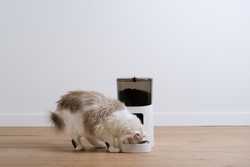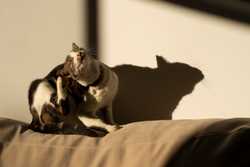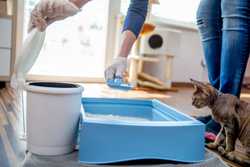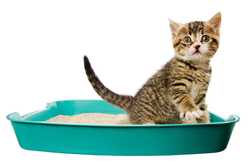How Much Should I Feed My Cat?
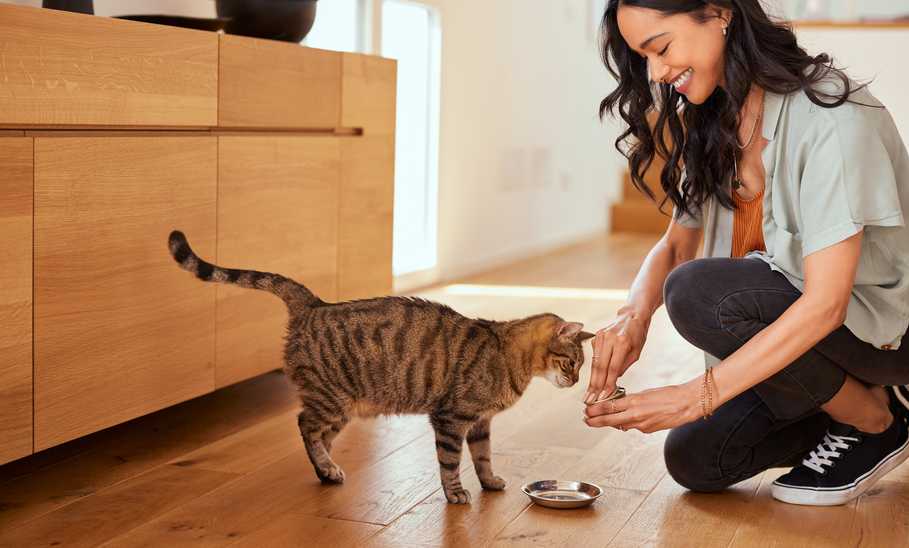
Our evaluations and opinions are not influenced by our advertising relationships, but we may earn a commission from our partners’ links. This content is created by TIME Stamped, under TIME’s direction and produced in accordance with TIME’s editorial guidelines and overseen by TIME’s editorial staff. Learn more about it.
If you have a cat or are considering getting one, knowing how much to feed them should be a top priority. As with all animals, no cat is exactly alike and each has their own dietary needs. While some broad nutrition rules apply to all felines, you might need to do things differently than what you did with another cat, or different from another pet owner. Figuring out what, when, and how much to feed your cat is one of the biggest contributors to a healthy lifestyle that will keep them happy and in good shape, so take some time to learn what your cat needs.
The stakes are high. Underfeeding or overfeeding your cat can lead to severe health complications in the long run, inhibiting their quality of life and leaving them vulnerable to disease and even death. Fortunately, there are a few quick ways to determine the rough amount of food that your cat should be getting each day. From there, you can experiment with different types of food and different meal times to identify the perfect feeding scheduling for your pet.
I spoke to Alec Wilson, DVM for his professional veterinary insight into cat health and nutrition, as well as to certified cat behaviorist Cristy Brusoe, to find out the best way to determine how much to feed your cat.
There’s a lot of useful (if general) guidance about the correct amount of food for cats, but remember that each cat is different. Several key factors may affect how much food they need to be happy and healthy, which you should be aware of.
You may think a younger, smaller cat will need less food than its older, larger counterpart, but this isn’t necessarily true. “Young cats will tend to eat more because they are growing,” says Dr. Wilson. Be careful not to deprive your kitten or young adult cat of important calories that will help them reach full maturation.
Larger animals will need more food than smaller animals to maintain a healthy weight at their size. With cats in particular, there is a lot of size variation between different breeds that will impact what a healthy weight looks like; a Maine Coon can weigh up to 25 pounds while a Siamese may be healthy at 5 pounds. If your cat weighs a lot because they have too much mass for their frame, you’ll want to help them get down to a healthier, smaller size. However, some cats are simply bigger than others and therefore need to eat more.
“[Eating more] would also apply to pregnant cats because the mother is feasting for more than just herself, which requires more kilocalories (kcal),” says Dr. Wilson. Whether your cat is growing her babies or feeding her babies milk, she will need more food — just like a woman does during pregnancy and nursing. Conversely, if your cat has been spayed or neutered, they will need fewer daily calories than an intact animal.
“Cats that are more active or have outdoor access may need more calories compared to sedentary indoor cats,” explains Brusoe. If you have a naturally curious animal that is playful and regularly exploring their environment, then they will need more energy to support these activities. Cats that used to be active but are now more lethargic could be suffering from a lack of calories, which has diminished their energy levels.
Veterinarians have come up with a useful calculation that can be used as a base metric for how much to feed your animal:
“Using the RER (kcal/day) equation is best,” says Dr. Wilson. “RER means the resting energy requirement of that animal. This is the amount of food needed for an animal at rest. Keep in mind this can change if the cat is obese, and/or needs to gain weight.”
For cats, the RER equation = 30 x (weight in kg) + 70. This means that for a cat that weighs 4 kg, they should eat 190 calories per day to meet their basic energy requirements and maintain their current weight. Remember, other factors may influence how much food they need, so don’t feel like you have to stick to this exact number; instead, use this as a starting point for figuring out the best feeding schedule for your animal. Dr. Wilson recommends the websites Pet Nutrition Alliance and Balance.It to help calculate calorie ranges.
First, it’s important to be sure your cat needs to lose weight. Some cats are simply larger than others, so weight alone isn’t always a clear indicator. One way to determine if your cat needs to lose weight is to look at their body condition score, which “helps assess whether a cat is underweight, overweight, or at an ideal weight,” explains Brusoe. Several graphics demonstrate what a good condition score looks like, which you can compare your cat to. In general, Dr. Wilson says that “a cat being fed too much will show an accumulation of fat in the waist, spine, hip, abdominal, and rib areas.”
If your cat is overweight, getting them down to a healthier size will be beneficial for their overall well-being. To do so, you can reduce their current food portion by 25 to 50%. Dr. Wilson recommends maintaining this one-time change for several weeks before assessing if this has the desired impact on your cat’s weight. However, be careful not to deprive your cat of too many calories as you don’t want them to lose weight too quickly because this can be damaging to their health.
“For weight loss, a good rule of thumb is to calculate 0.8 x your cat’s RER, and then feed this amount until ideal results are achieved,” says Dr. Wilson. “Once at the appropriate weight, a normal RER can be fed.”
If your cat is underweight, they may have visible ribs or bones, or a noticeable lack of body fat. Cats need some body fat to help regulate their temperature and metabolize their food properly, so it’s important for your cat to gain weight and fat if they currently have a low body condition score. Make sure you calculate your cat’s RER and that you’re feeding them at least this amount. Another method is to increase their current food intake by 25 to 50%, the inverse of the weight-loss method.
If your cat is receiving this amount of food but is still underweight, consider consulting a veterinarian to rule out any underlying health conditions that may be preventing weight gain.
Once you’ve figured out how many calories your cat needs per day, you’ll need to apply this to their food to determine how much wet and/or dry food your cat should eat. Luckily, cat food manufacturers have to provide the caloric information of their products and will list the nutritional profile on the containers. You may see this written as “kcals,” which are the same thing as calories.
To determine how much food will provide the needed calories, divide your cat’s daily caloric intake by the caloric content of their food, which will be listed per can (wet food) or cup (dry food). For instance, say your cat requires 250 calories a day and the wet food brand you buy has 100 calories per 3 ounce can. 250 divided by 100 = 2.5 cans. This means that your cat needs to consume two and a half of those cans every day to meet their required daily intake.
You may also choose to feed your cat a combination of wet and dry food. In this case, you simply need to make sure the amount of calories they get from wet food, combined with the calories they get from dry food, totals their daily amount. So the cat that requires 250 calories per day could eat one 100-calorie can of food and 150 calories worth of dry food to maintain a healthy weight.
Remember: Cat treats also contain calories and it’s recommended that the total caloric intake from treats doesn’t exceed 10% of their total daily intake. If you like to feed your cat lots of treats, reduce the calories they get from their regular food to maintain the daily total.
“It does not matter how often a cat eats in a day as long as they are getting the correct amount of food daily,” says Dr. Wilson. “A cat can eat many times throughout the day or have a set amount of food given two to three times a day.” That said, it can be helpful to learn what your cat prefers so you can ensure they actually eat the right amount of food per day.
“Cats are natural grazers and prefer multiple small meals throughout the day,” says Brusoe, so consider dividing your pet’s daily food intake into several portions that it can eat regularly. At minimum, split their food into two amounts but up to six is even better. Small but numerous portions are especially important when feeding your cat wet food, as it can congeal and become unappetizing if a large amount sits out for too long. If you aren’t around to provide these regular feedings, consider getting an automatic cat feeder that can dispense food at approved times even when you’re out of the house. If dry food is part of your feeding schedule, this is an easy thing to leave out throughout the day for your cat to nibble at as they please — but be wary of leaving too much as this could lead to overeating and weight gain.
Whichever approach you take, consistency is one of the most important things. “Offering meals at consistent times can help establish a routine and prevent overeating or begging behaviors,” explains Brusoe. If your cat knows to expect food at a certain time, they are less likely to become anxious and cause a fuss when they get hungry.
A good sized cat dish will be one that can comfortably accommodate a serving of food. Depending on the size of your cat, they may need a larger or smaller dish than other cats. More important than the size of the dish is its shape. Cats prefer a shallow bowl or plate that won’t require them to strain their neck or back when eating. Wider dishes are also best as this will keep their whiskers from rubbing up against the sides, which can be unpleasant and overstimulating.
| Weight | Typical pet, spayed/neutered | Typical pet, intact | Typical pet, prone to gaining weight | Typical pet, in need of weight loss | Typical pet, nursing |
|---|---|---|---|---|---|
5 pounds (2.3 kg) | 157 kcal/day | 183 kcal/day | 131 kcal/day | 105 kcal/day | 336 kcal/day |
7.5 pounds (3.4 kg) | 210 kcal/day | 245 kcal/day | 175 kcal/day | 140 kcal/day | 469 kcal/day |
10 pounds (4.5 kg) | 260 kcal/day | 303 kcal/day | 216 kcal/day | 173 kcal/day | 603 kcal/day |
12.5 pounds (5.7 kg) | 298 kcal/day | 362 kcal/day | 258 kcal/day | 207 kcal/day | 727 kcal/day |
15 pounds (6.8 kg) | 354 kcal/day | 413 kcal/day | 295 kcal/day | 236 kcal/day | 851 kcal/day |
17.5 pounds (7.9 kg) | 396 kcal/day | 462 kcal/day | 330 kcal/day | 264 kcal/day | 971 kcal/day |
20 pounds (9.1 kg) | 440 kcal/day | 513 kcal/day | 367 kcal/day | 293 kcal/day | 1091 kcal/day |
While these numbers are a great starting point to feeding your cat the right amount, you’ll likely need to experiment to find the exact right schedule for your animal. To determine whether your current method is working, observe your cat and assess their eating habits, activity levels, and general behavior. This will reveal whether they’re feeling nourished and taken care of, or whether they may be over- or under-eating.
Dr. Wilson described some signs that your cat is getting the right amount of food: “A cat grazing multiple times throughout the day. The cat will have a tapered waist when looking down at them from above. The ribs will not be easily seen when looking at the cat, however, they are easily felt when petting the cat. An abdominal tuck can be seen. They will have plenty of energy for playing around and having the zoomies.”
Meanwhile, some signs that your feeding schedule isn’t working include: “A cat that is being fed too much…may breathe a bit heavier when engaging in minimal to normal activity. They tend to be a bit more sedentary, and it's hard for them to get up or off the ground to walk around. Too little food may be indicated by weakness, lethargy, easily visible ribs/bones, lack of body fat, and loss of muscle mass.”
If your cat is prone to eating quickly and getting over-excited at meal times, Brusoe recommends “using puzzle feeders or interactive feeding toys to encourage mental stimulation and slow down eating.” This reduces the chance of your cat throwing up their food and the risk of them overeating due to boredom or easy access.
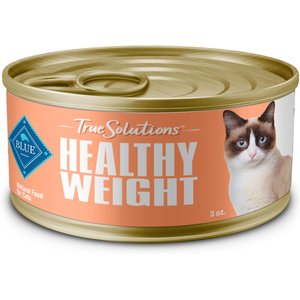
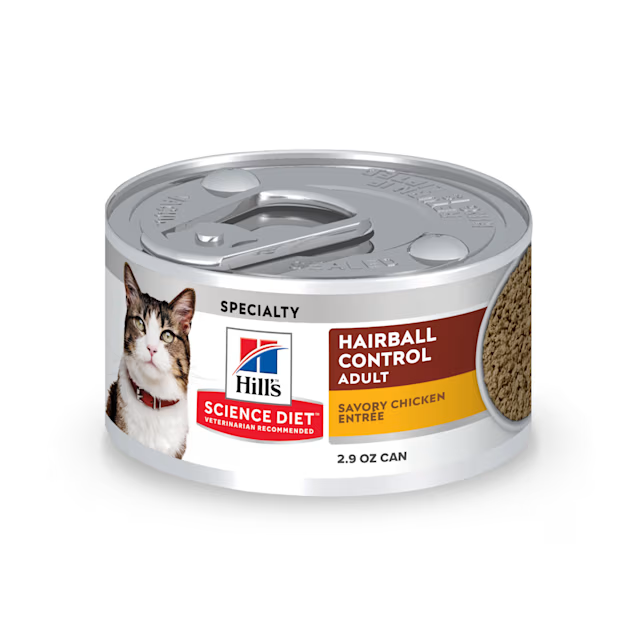
It is possible for a cat to survive without food for two to three days, says Dr. Wilson, but this is not recommended. More than 24 hours without food is detrimental to the cat and may cause long-term health issues if it occurs regularly. If you are often away overnight, consider investing in an automatic feeder that will keep your cat on a consistent feeding schedule, or enlist someone to come in and feed the cat as needed.
“This can depend on a lot of factors,” says Dr. Wilson. “However, cats tend to have fast metabolisms. This will lead them to eat small amounts of food many times throughout the day.” If you notice your cat is regularly asking for food or hanging around their dish, consider dividing the daily amount of food into smaller portions so they can enjoy it throughout the day. You can also supplement with treats between meals, just don’t go overboard as this can lead to accidental weight gain. However, if your cat is hungry and losing weight or having other symptoms, they need to be seen by a veterinarian.
This will depend on the size of the can and the nutritional requirements of your cat, but two cans will likely be too much if you’re buying the larger size cans (5.5 ounces).
“On average, two cans of food is generally too much food for a cat per day,” warns Dr. Wilson. “For example, an ideal 12-pound male neutered cat will have an RER of 233 to 300 kcal/day. One can of Friskies® can have 174kal/can. If this cat were to have two cans a day, that would be 348 kcal, which exceeds the recommended RER. Feeding this amount over time would lead to an unwanted weight gain.”
Always check the caloric content of the cat food you buy and compare this against the cat’s RER to make sure you’re not under- or over-feeding.
The information presented here is created by TIME Stamped and overseen by TIME editorial staff. To learn more, see our About Us page.
